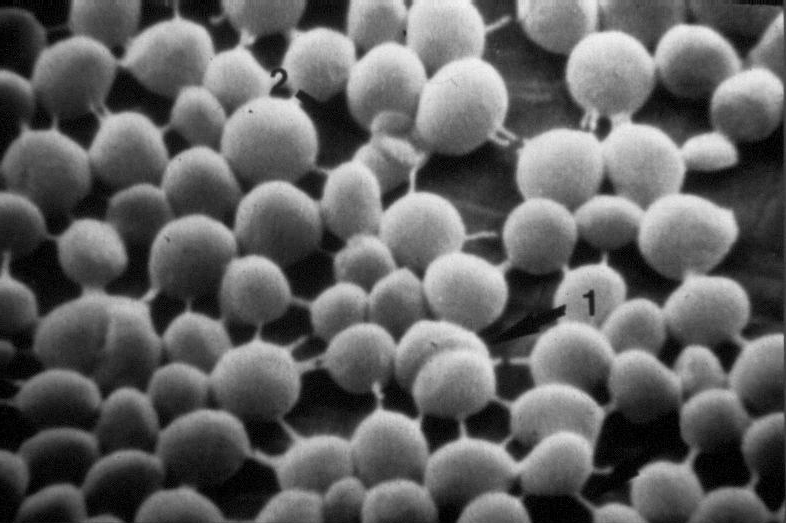(1).gif)
(1).gif)
![]()

Click Here to View More Images of Staphylococci
![]() Nonmotile
Gram-positive facultative anaerobic
cocci (see WebLinked
image; see WebLinked
image; see WebLinked
image)
Nonmotile
Gram-positive facultative anaerobic
cocci (see WebLinked
image; see WebLinked
image; see WebLinked
image)
![]() Microscopically
cells occur singly and in pairs, short chains, and grape-like clusters
Microscopically
cells occur singly and in pairs, short chains, and grape-like clusters
![]() Both respiratory and fermentative metabolism; Nitrate often reduced to nitrite
Both respiratory and fermentative metabolism; Nitrate often reduced to nitrite
![]() Capsule
or slime layer (diffuse capsule)
may be present more commonly in vivo; Particularly important in Staphylococcus
epidermidis colonization
Capsule
or slime layer (diffuse capsule)
may be present more commonly in vivo; Particularly important in Staphylococcus
epidermidis colonization
![]() Cell
wall contains teichoic acid
Cell
wall contains teichoic acid
Ribitol teichoic acid (Polysaccharide A) in Staphylococcus aureus
Glycerol teichoic acid (Polysaccharide B) in S. epidermidis
![]() Enzymes:
Enzymes:
![]() Protein
A
Protein
A
Uniformly coats surface of S. aureus
Not present on coagulase-negative staphylococci
![]() S.
aureus ferments mannitol; Most other staphyloccocci are mannitol negative
S.
aureus ferments mannitol; Most other staphyloccocci are mannitol negative
![]() Halotolerant
(grow in medium containing < 10% NaCl); Salt is useful as a selective
constituent in isolation media
Halotolerant
(grow in medium containing < 10% NaCl); Salt is useful as a selective
constituent in isolation media
![]() Wide
temperature range for growth (18oC - 40oC)
Wide
temperature range for growth (18oC - 40oC)
![]() Staphylococcal
strains vary in pigmentation and susceptibility to antibiotics
Staphylococcal
strains vary in pigmentation and susceptibility to antibiotics
S. epidermidis and other coagulase-negative staphylococci:
Cutaneous Infections:
Furuncles (boils)
Impetigo
Bullous impetigo
Pustular impetigo
Wound infections
Scalded skin syndrome: neonates and children under the age of four
Toxic-shock syndrome
Food poisoning
Other infections:
Pneumonia
Empyema
Bacteremia (hospital-acquired)
Osteomyelitis: disease of growing bone
Septic arthritis
Septic embolization
Metastatic infections
Staphylococcus saprophyticus:
Endocarditis: infections of either native or artificial heart valves
Catheter and shunt infections
Prosthetic joint infections
Other opportunistic infections
Urinary tract infections in sexually active young women
![]() Staphylococci
are common flora: skin, nasal cavity, oropharynx, gastrointestinal tract, genitourinary
tract
Staphylococci
are common flora: skin, nasal cavity, oropharynx, gastrointestinal tract, genitourinary
tract
![]() Transient
colonization by S. aureus
Transient
colonization by S. aureus
![]() Transmission
by direct contact or by fomite
Transmission
by direct contact or by fomite
![]() Carrier
state: short or long-term, often colonizing the anterior nares
Carrier
state: short or long-term, often colonizing the anterior nares
![]() Nosocomial
infections
Nosocomial
infections
Somatic virulence factors:
Enzymes:
Coagulases:
- bound (clumping factor)
- free (coagulase-reacting factor)
Hyaluronidase: "spreading factor" of S. aureus
Nucleases: S. aureus; Cleaves DNA (DNase) and RNA (RNase)
Fibrinolysin: staphylokinase
Lipases: esterases
Penicillinase
Exotoxins:
Cytotoxins (hemolysins): cytopathic and cytolytic for a broad range of affected cells, including erythrocytes, leukocytes, macrophages, hepatocytes, lymphocytes, lymphoblasts, fibroblasts, neutrophils and platelets
Alpha toxin
Beta toxin: sphingomyelinase C (phospholipase)
Delta toxin: detergent-like activity
Gamma toxin: hemolytic activity
Leukocidin
Enterotoxins (A to E)
Exfoliative toxin (epidermolytic toxin or exfoliatin) (A and B)
Toxic shock syndrome toxin-1 (TSST-1) (formerly pyrogenic exotoxin C)
Slime layer (capsule)
Protein A: binds Fc receptors of IgG
Teichoic acid: binds fibronectin
![]() Microscopy:
gram reaction and morphology
Microscopy:
gram reaction and morphology
![]() Culture
and biochemical confirmation
Culture
and biochemical confirmation
![]() Serology
Serology
![]() Drain
infected area
Drain
infected area
![]() Deep/metastatic
infections: semi-synthetic penicillins; cephalosporins, erythromycin or clindamycin
Deep/metastatic
infections: semi-synthetic penicillins; cephalosporins, erythromycin or clindamycin
![]() Endocarditis:
semi-synthetic penicillin plus an aminoglycoside
Endocarditis:
semi-synthetic penicillin plus an aminoglycoside
![]() Carrier
status prevents complete control
Carrier
status prevents complete control
![]() Proper hygiene, segregation of carriers from highly susceptible individuals
Proper hygiene, segregation of carriers from highly susceptible individuals
![]() Good
aseptic techniques when handling surgical instruments
Good
aseptic techniques when handling surgical instruments
![]() Control
of nosocomial infections
Control
of nosocomial infections
(1).gif) Go to Pathogen List
Go to Pathogen List| Lecture Syllabus | General Course Information | Grade Determination |
| Laboratory Syllabus | Interesting WebSite Links | Lab Safety |